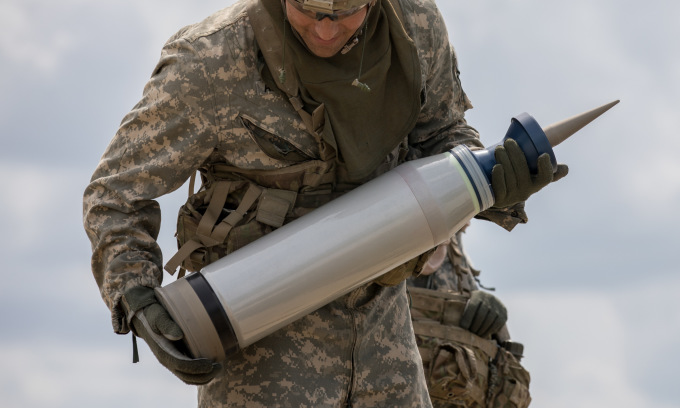The Pentagon announced it was providing Ukraine with depleted uranium ammunition for use on M1 Abrams tanks, marking the first time Washington has shipped such ammunition to Kiev.
The US Department of Defense on September 6 announced a new security aid package worth a total of $175 million for Ukraine, including depleted uranium (DU) ammunition for the 120mm cannon on the M1 Abrams tank, ammunition for the HIMARS rocket launcher and 155mm cannon, equipment to support Ukraine's air defense system, and many other types of weapons.
The aid is under the Presidential Availability Authority (PDA), which allows the US government to flexibly transfer some of its defense resources and inventory to partners in emergency situations without waiting for congressional approval.

US soldiers train with M829A4 kinetic energy penetrator rounds from an Abrams tank in 2021. Photo: US Army
This is part of a more than $1 billion aid package announced by US Secretary of State Antony Blinken during a visit to the capital Kiev.
The Russian Embassy in the US called the decision to supply DU artillery shells to Ukraine a "sign of inhumanity", stressing that Washington was "deceiving itself" by not admitting that Kiev's major counteroffensive had failed.
DU munitions contain a byproduct of uranium enrichment for nuclear fuel and weapons. DU has a radioactive U235 isotope content of less than 0.3%, lower than the 0.72% found in natural ore, with the main component being the less radioactive and fissile U238 isotope.
The White House has debated for weeks the possibility of providing DU munitions to Ukraine, with some officials arguing that the transfer would expose Washington to criticism because DU munitions raise concerns about environmental and human health risks.
US National Security Council spokesman John Kirby said in March that Russia opposed Western aid to Ukraine with DU munitions because it feared their tanks would be destroyed by them. He also asserted that DU munitions were "quite common and studies have shown that they do not pose a radiological threat."
In a 2022 report, the United Nations Environment Programme expressed concern that DU's chemical toxicity was the biggest potential hazard, with the potential to "cause skin irritation, kidney failure and increased cancer risk."
The US Department of Veterans Affairs says DU emits high-energy alpha particles but has low penetrability, unable to penetrate clothing or human skin. Health effects mainly occur if the material enters the body through open wounds, the airways, and the gastrointestinal tract.
However, DU, after burning, can react with corrosive substances in water and air, forming toxic compounds that can enter the body through food and water, gradually accumulating in organs such as the liver, spleen and kidneys. A study by Harvard University in the US said that DU is harmful to both soldiers in combat and local residents.
Vu Anh (According to Reuters )
Source link







![[Photo] T&T 1 and Ho Chi Minh City 1 People's Police Teams won the men's and women's team championships](https://vphoto.vietnam.vn/thumb/1200x675/vietnam/resource/IMAGE/2025/5/22/39db06ae67cb4001b7a556e8d9a56d07)


























































































![[Podcast] Week introducing more than 500 OCOP products in Hanoi](https://vphoto.vietnam.vn/thumb/402x226/vietnam/resource/IMAGE/2025/5/22/d144aac2416744718388dbae3260e7fd)

Comment (0)